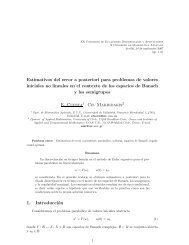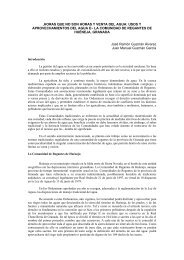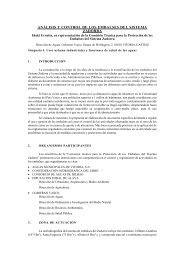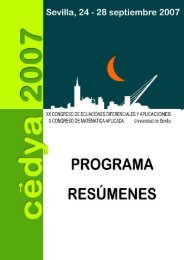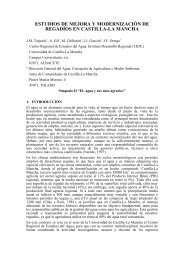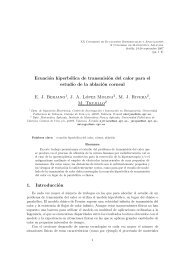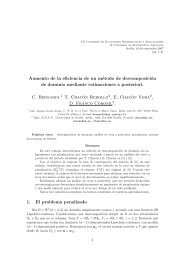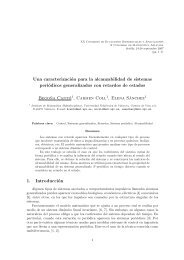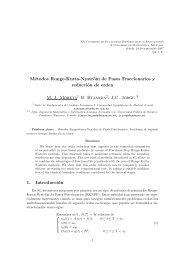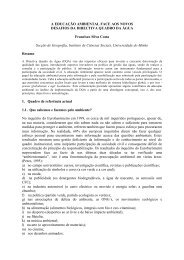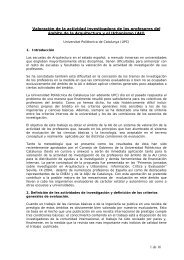LIBRO DE ACTAS (pdf) - Universidad de Sevilla
LIBRO DE ACTAS (pdf) - Universidad de Sevilla
LIBRO DE ACTAS (pdf) - Universidad de Sevilla
Create successful ePaper yourself
Turn your PDF publications into a flip-book with our unique Google optimized e-Paper software.
Retentional Syntagmatic Network, and its Use in Motivic Analysis of Maqam Improvisation<br />
drawn on a same musical passage. For instance, the second grace note Bb at the beginning of the<br />
improvisation can be un<strong>de</strong>rstood:<br />
as a simple ornamentation of the subsequent note G, following the logic of the previous<br />
ornamentation Bb-A,<br />
as part of a green pattern Bb-G-A,<br />
as part of a black <strong>de</strong>scending line Bb-A-G-F-E-D.<br />
The algorithm is un<strong>de</strong>r <strong>de</strong>velopment. In or<strong>de</strong>r to offer a compact representation of the results,<br />
as shown in the figure, some additional mechanisms need to be ad<strong>de</strong>d, such as the <strong>de</strong>tection of<br />
internal cycles within a pattern, as indicated by the repeat bars in the representation of the first<br />
pattern in Figure 4.<br />
4. Beyond Gestalt segmentation<br />
4.1 Separability of segmentation mo<strong>de</strong>ls<br />
In formalized and computational approaches of structural analysis of music, one core<br />
mechanism consists in <strong>de</strong>composing the stream of music into segments and, in multi-level<br />
hierarchical mo<strong>de</strong>ls, segments are themselves <strong>de</strong>composed into subsegments and so on. This<br />
corresponds in particular to the Grouping Structure in the GTTM (Lerdahl & Jackendoff, 1983)<br />
or to Tenney and Polansky (1980)’s mo<strong>de</strong>l. Applications to polyphony have been consi<strong>de</strong>red<br />
similarly as a <strong>de</strong>composition of the polyphonic flow into segments of streams (Lerdahl, 1989;<br />
Rafailidis et al, 2008).<br />
This hierarchical segmentation of music face two major limitations:<br />
This forces one single hierarchical un<strong>de</strong>rstanding of the structural organization of the<br />
musical material. Refined motivic analyses often show how particular musical elements<br />
can be organized in various ways, and that such structural polysemy can be easily<br />
un<strong>de</strong>rstood by the listener.<br />
Such compartmentation conceals the rich interconnection that could be drawn between<br />
notes that belong to different clusters. In hierarchical segmentation mo<strong>de</strong>ls, segments are<br />
represented in the upper level by reducing their content into one single note: the<br />
interconnection between neighbor segments is represented by an interconnection<br />
between the anchor note of each segment. This solution allows in<strong>de</strong>ed interconnections<br />
rising above the strict taxonomy, but practical examples can show how limited this<br />
solution remains.<br />
It seems therefore that a strict hierarchical segmentation mo<strong>de</strong>l is not enough to <strong>de</strong>scribe the<br />
richness of musical structure.<br />
4.2 Connectivity of the RSN<br />
Surpassing those important limitations requires a change of paradigm. In or<strong>de</strong>r to formalize<br />
clustering of notes without forcing one taxonomy out of others, instead of focusing on the<br />
separability between notes, as traditional segmentation mo<strong>de</strong>l would do, we propose to focus on<br />
the connectivity between notes, based, here also, on the RSN.<br />
A weight, called syntagmatic weight, could be associated with each connection between two<br />
notes. The introduction of fuzziness allows to transcend a purely binary <strong>de</strong>composition of the<br />
structure, and offers multiple ways of <strong>de</strong>ciphering the organization <strong>de</strong>pending on the weight<br />
threshold chosen as point of view. This syntagmatic network is a generalization of the<br />
hierarchical segmentation mo<strong>de</strong>l, which corresponds to a special case with binary syntagmatic<br />
weight (0: no connection, 1: connection).<br />
These interconnections between notes can be un<strong>de</strong>rstood not only as the skeleton of what we<br />
consi<strong>de</strong>red as segments, but also as indicators of longer-range connections between notes that, in<br />
215



